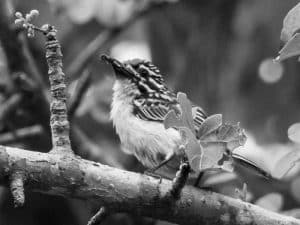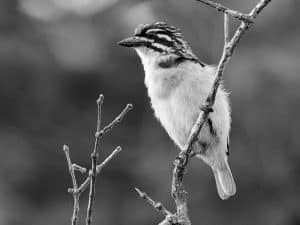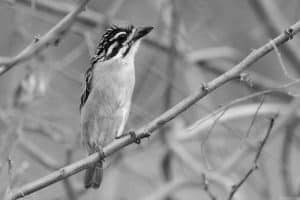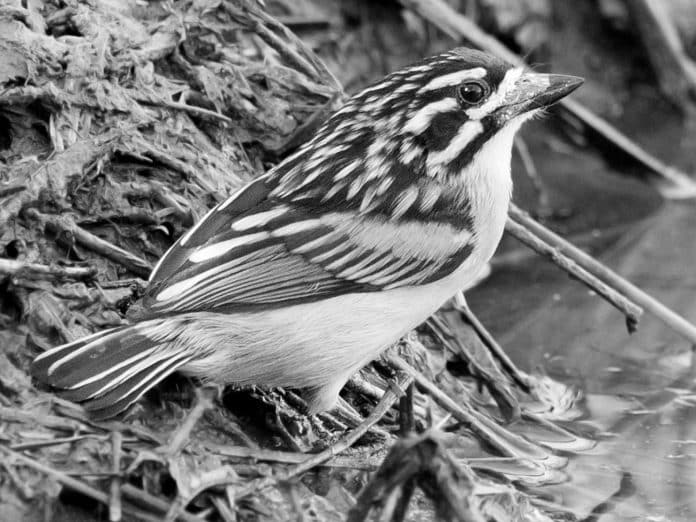Introduction to the Red-Fronted Tinkerbird
Welcome to the enchanting world of the Red-Fronted Tinkerbird in Tanzania, a small but striking bird species that captivates birdwatchers and nature enthusiasts with its vibrant plumage and melodious chirps. The Red-Fronted Tinkerbird, scientifically known as Pogoniulus pusillus, is a member of the barbet family and is native to the lush woodlands and tropical forests of Tanzania. Its captivating appearance and unique vocalizations make it a sought-after sight for birdwatchers and wildlife photographers visiting the region.

The Red-Fronted Tinkerbird is a charismatic avian species known for its diminutive size, measuring around 9 to 10 centimeters in length. Despite its small stature, this bird possesses a remarkable presence in its natural habitat, often drawing attention with its vivid colors and distinct calls. As we delve deeper into the world of the Red-Fronted Tinkerbird, you will gain a comprehensive understanding of its habitat, physical characteristics, behavior, and the efforts dedicated to its conservation in Tanzania.
Habitat and Distribution of the Red-Fronted Tinkerbird in Tanzania
The Red-Fronted Tinkerbird inhabits a diverse range of habitats across Tanzania, including lowland and montane forests, wooded savannas, and riverine woodlands. These birds are particularly fond of dense vegetation, where they can easily forage for insects and fruits while seeking shelter amidst the foliage. Their distribution spans various regions of Tanzania, with sightings reported in the Eastern Arc Mountains, the Uluguru Mountains, the Usambara Mountains, and the Southern Highlands. These areas provide the ideal combination of suitable nesting sites, abundant food sources, and a favorable climate for the Red-Fronted Tinkerbird to thrive.
In addition to their primary habitats, these tinkerbirds are also known to frequent agricultural areas with scattered trees and shrubs, demonstrating their adaptability to human-altered landscapes. However, the conservation of their natural forest habitats remains crucial to sustaining viable populations of the Red-Fronted Tinkerbird in Tanzania. By understanding the specific ecosystems they rely on, conservationists and enthusiasts can work towards preserving these vital environments and ensuring the long-term survival of this captivating species.
Physical Characteristics and Plumage of the Red-Fronted Tinkerbird
The Red-Fronted Tinkerbird showcases a stunning array of colors and patterns, making it a visual marvel amidst the verdant canopies of Tanzania’s forests. Its most prominent feature is the vibrant red patch adorning its forehead, which contrasts beautifully with the glossy black plumage covering its head, back, and wings. The bird’s underparts are adorned with a striking combination of yellow, white, and black, creating a captivating mosaic of hues that dazzles observers fortunate enough to catch a glimpse of this elusive species.
In addition to its colorful plumage, the Red-Fronted Tinkerbird displays subtle yet exquisite details, such as its slender bill and agile movements as it flits among the branches in search of sustenance. Its diminutive size and swift, acrobatic flights further add to the charm of encountering these birds in their natural habitat. By understanding the intricate details of their physical attributes, birdwatchers and conservationists can appreciate the unique adaptations that enable the Red-Fronted Tinkerbird to thrive in the diverse landscapes of Tanzania.
Behavior and Vocalizations of the Red-Fronted Tinkerbird
The behavior of the Red-Fronted Tinkerbird offers a fascinating insight into the daily lives of these avian marvels. Their foraging activities primarily revolve around probing for insects, spiders, and small fruits within the foliage of trees and shrubs. Their agile movements and adeptness at navigating dense vegetation reflect their specialized adaptations for life in the forest understory, where they can exploit a wide range of resources to sustain themselves.
One of the most captivating aspects of the Red-Fronted Tinkerbird’s behavior is its vocal repertoire. These birds are renowned for their melodious calls, which echo through the forest and serve as a distinctive feature of the avian symphony in Tanzania. Their calls are often characterized by a series of rapid, metallic notes, resembling the sound of a tinkling hammer against metal, hence lending them the name “tinkerbird.” The intricate vocalizations of these birds play a vital role in communication, territorial defense, and courtship, adding a musical dimension to the natural ambiance of their woodland habitats.
Conservation Status and Threats Faced by the Red-Fronted Tinkerbird

Despite its captivating presence, the Red-Fronted Tinkerbird faces a range of threats that jeopardize its long-term survival in Tanzania. Habitat loss and fragmentation due to deforestation, agricultural expansion, and human development pose significant challenges to the stability of the ecosystems where these birds reside. The degradation of their forest habitats not only diminishes the available resources for the tinkerbirds but also exposes them to increased predation and competition from other species.
Furthermore, the illegal wildlife trade and unsustainable trapping for the pet bird industry further exacerbate the pressures faced by the Red-Fronted Tinkerbird populations. As a result, the conservation status of these birds is a cause for concern, prompting concerted efforts from conservation organizations, governmental agencies, and local communities to safeguard their future. By understanding the specific threats and challenges confronting the Red-Fronted Tinkerbird, conservationists can develop targeted interventions to mitigate these risks and foster the recovery of their populations across Tanzania.
Best Locations for Birdwatching and Spotting the Red-Fronted Tinkerbird in Tanzania
Tanzania offers a wealth of opportunities for birdwatchers and nature enthusiasts to observe the Red-Fronted Tinkerbird in its natural environment. The Eastern Arc Mountains, encompassing the Udzungwa and Uluguru Mountains, stand out as prime locations for encountering these captivating birds amidst the verdant montane forests. The intricate network of trails and diverse habitats within these mountain ranges provides an ideal setting for birdwatching excursions focused on the Red-Fronted Tinkerbird and other avian treasures native to Tanzania.
In addition to the Eastern Arc Mountains, the Usambara Mountains and the Southern Highlands present rewarding destinations for spotting the Red-Fronted Tinkerbird. These regions boast rich biodiversity and scenic landscapes, offering ample opportunities to observe and photograph these charismatic birds amid the lush vegetation. By exploring the designated nature reserves, protected areas, and community-managed forests in these locations, birdwatchers can immerse themselves in the captivating allure of the Red-Fronted Tinkerbird’s natural habitats.
Tips for Birdwatching and Photographing the Red-Fronted Tinkerbird
When embarking on a birdwatching adventure to observe the Red-Fronted Tinkerbird in Tanzania, it is essential to equip yourself with the necessary knowledge and tools to enhance your experience. Patience and perseverance are key virtues when seeking out these elusive birds, as their small size and agile movements can make them challenging to spot amidst the dense foliage. Utilizing binoculars or a spotting scope can greatly aid in scanning the treetops and understory for glimpses of the tinkerbirds as they go about their foraging and vocalizing activities.
In addition to honing your observational skills, familiarizing yourself with the distinct calls and vocalizations of the Red-Fronted Tinkerbird can significantly improve your chances of locating them within their habitat. Learning to recognize their unique calls and understanding their behavior patterns can guide your efforts in identifying and appreciating these avian gems. Furthermore, practicing ethical birdwatching and photography techniques, such as maintaining a respectful distance and minimizing disturbances, is essential for ensuring the well-being of the tinkerbirds and preserving the integrity of their natural surroundings.
Unique Facts and Folklore Surrounding the Red-Fronted Tinkerbird in Tanzanian Culture
The Red-Fronted Tinkerbird holds a special place in Tanzanian culture, where it is often revered for its beauty and celebrated in local folklore. Across various communities, the vibrant colors and enchanting calls of the tinkerbird have inspired tales and traditions that highlight its significance in the natural world. Stories depicting the resilience and grace of these birds are passed down through generations, enriching the cultural tapestry of Tanzania with the mystique of the Red-Fronted Tinkerbird.
In addition to its cultural symbolism, the Red-Fronted Tinkerbird contributes to the ecological balance and biodiversity of Tanzania’s forests, playing a vital role in seed dispersal and insect control within its habitat. Its presence serves as a testament to the interconnectedness of all living beings, underscoring the importance of preserving the rich tapestry of wildlife that enriches the landscapes of Tanzania. By acknowledging the cultural reverence and ecological contributions of the Red-Fronted Tinkerbird, we gain a deeper appreciation for the intrinsic value of these avian treasures and the need to protect their natural heritage.
Efforts and Initiatives for the Conservation of the Red-Fronted Tinkerbird

The conservation of the Red-Fronted Tinkerbird in Tanzania is a collaborative endeavor that involves a diverse array of stakeholders dedicated to safeguarding the species and its habitat. Conservation organizations, such as the Wildlife Conservation Society of Tanzania and the Tanzania Forest Conservation Group, play pivotal roles in conducting research, implementing habitat restoration projects, and raising awareness about the plight of the tinkerbirds. By working closely with local communities and governmental agencies, these organizations strive to address the underlying drivers of habitat loss and degradation while fostering sustainable coexistence between people and wildlife.
Furthermore, initiatives focused on community-based conservation and ecotourism empower local residents to actively participate in the protection of the Red-Fronted Tinkerbird and its forest habitats. By promoting sustainable livelihoods and environmental education, these efforts contribute to the preservation of the ecosystems that support the tinkerbirds and numerous other species in Tanzania. Engaging in ecotourism activities, such as birdwatching tours and wildlife photography expeditions, also generates economic incentives for conservation, thereby reinforcing the value of preserving the natural heritage of Tanzania for future generations.
Conclusion
In conclusion, the Red-Fronted Tinkerbird in Tanzania embodies the captivating beauty and ecological significance of the avian world, captivating enthusiasts and conservationists alike with its vibrant plumage and melodious calls. As we traverse the diverse habitats and cultural landscapes of Tanzania, we gain a profound appreciation for the intricate connections between the tinkerbirds, their natural environment, and the communities that cherish their presence. By embracing the spirit of conservation and celebrating the diverse tapestry of life that thrives in Tanzania, we can ensure that the Red-Fronted Tinkerbird continues to enchant generations to come, serving as a living testament to the wondrous allure of the natural world.

































